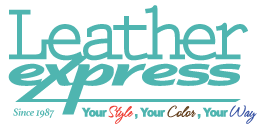Full aniline leather dyeing
Full aniline leather dyeing is suitable only for the very best full grain hides that have few imperfections on the surface. During the tanning process, the hides are soaked with a translucent dye in large rotating stainless steel drums. The dye is absorbed by the pores of the leather, permeates the surface of the hide, and combines with the high fibers to form an insoluble compound. This process gives the hide color without covering over its natural markings or enhancing the subtle variations. Due to the dyeing process that is used, aniline leather is less stain resistant, but stays softer and more pliable than leather with other finishes. Because of the absence of a surface finish, aniline leather ages differently than most. Over the course of time it will develop a beautiful patina finish that will add to the natural character of your furniture.
Top Grain
Top grain leather can be processed into corrected grain leather, where surface imperfections are buffed and sanded out, then embossed to restore a natural-looking grain pattern. Full grain leather can also be made from top grain leather. This occurs when the grain of the leather is not mechanically altered and left in its natural state.
Split Grain
The lower layer on the hide is called split leather. It is stiffer and less durable than top grain leather. However, is still suitable for areas of furniture that are not seen, and that do not need to be as flexible as the top. Split leather has less strength and durability because the fibers of the hide run in one direction, which leaves it more susceptible to cracking or tearing.
Semi aniline leather
Semi aniline leather offers the softness of aniline leather but provides the surface protection and color uniformity of pigmented leathers. The hide goes through the same drum dyeing process as the aniline leather, but a second supplemental step also follows. A light top coating of highly dispersed pigments and dyes is added to the aniline-dyed hide to even out the color of the hide’s surface; however, any large imperfections on the surface will still be visible. The topcoat also serves to create fade and soil resistant pieces. Semi-aniline leathers are available in a multitude of colors. They retain a great amount of the softness of aniline-dyed hides because the natural top grain is left intact.
Pigmented leather
Pigmented leather is more durable and easier to maintain than aniline or semi aniline leathers; therefore, it is ideal for heavy use or active families. Tanneries use hides that are not suitable for aniline or semi aniline leathers to create pigmented leathers. These hides usually have naturally occurring imperfections that are first lightly sanded or buffed, then embossed to give the surface a uniform grain. Most pigmented leathers are drum dyed, and then an additional coating containing opaque pigments and a protective coating is applied. Although some of the natural softness is sacrificed in the process, pigmented leathers are easy to maintain and have maximum resistance to wear, soiling, and fading from light.
Bonded Leather
The term serves no purpose other than to permit the use of the word “leather” to be associated with the product. This is really a PU (polyurethane) product that has leather shavings sprayed onto the back. The top layer showing the outer color and texture is PU. The strength and carrier of the product is a thin fabric in the center. The leather shavings are applied on the back as described. Leather Express Does Not Sell Bonded or Blended Leathers.
Buffed Leather
Leather from which the top surface has been removed by abrasion. Often known as suede or nubuck.
Corrected Grain
Leather that has been buffed to remove blemishes, then covered with a new, artificial grain created using pigments and other finishes.
Distressed
Leather that has been “stamped” with a pattern applied by extreme pressure in a press to give a unique design or imitation of full grain characteristics. Sometimes leathers are embossed to make them appear to be another leather, such as embossing an alligator pattern into cowhide.
Embossed Leather
Leather that has been “stamped” with a pattern applied by extreme pressure in a press to give a unique design or imitation of full grain characteristics. Sometimes leathers are embossed to make them appear to be another leather, such as embossing an alligator pattern into cowhide.
Full Aniline
Leather receiving its color from dyes, however may receive a topical stain, wax, and/or water repellant.
Full Grain Leather
Leather which has not been altered beyond hair removal. Full grain leather is the most genuine type of leather, as it retains all of the original texture and markings of the original hide.
Glazed Leather
Aniline-dyed leather which has been polished to a high luster by passing through glass or steel rollers under great pressure.
Imitation
A variety of materials which have been made to resemble genuine leather. The great bulk of these are rubber or plastic-coated fabrics. It is unlawful to use terms connoting leather to describe imitations.
Leather Match
This term is used to describe an upholstered product where a portion of the product is real leather but the back, sides or less visible parts are constructed of an artificial material, usually vinyl. It is matched to look like leather. Leather-match is often used on motion furniture or recliners but can be used on any upholstered product. It is a method of creating a product that offers the sight and touch of real sofa leather but significantly reduces the final price.
Naked
A leather with no surface, impregnated treatment of finish other than dye matter which might mask or alter the natural state of the leather. Usually reserved for the finest quality skins.
Natural Grain
A leather that displays its original grain.
Nubuck
A leather whose surface has been buffed and brushed to create a soft, velvety effect. Differs from suede in that while suede is created from the flesh (inner) side of a hide, nubuck is created using the grain (outer) side, giving it added strength and durability.
Pigmented Leather
Leather that has been coated with a flat surface color on top of or instead of the usual dye finish. Leather is usually pigmented to add durability and hide natural blemishes.
Protected Leather
This is simply another way of saying “corrected” leather, except it may not be limited to top-grain. It refers to the fact that enough paint or other finish was applied to make the surface more durable than a more natural and less-processed leather.
Pure Aniline
Leather which receives all its color from dyes only and exhibits natural markings and characteristics.
Two-tone
An effect created by applying layers of similar or contrasting dyes to a piece of leather in order to create a mottled or aged appearance. Antiqued and Sauvaged leathers are examples of two-tone leathers.
Split Leather
Leather made from the lower (inner or flesh side) layers of a hide that have been split away from the upper, or grain, layers. Split leather is more fragile than side leather or full-grain leather, and is typically used in the form of suede.


